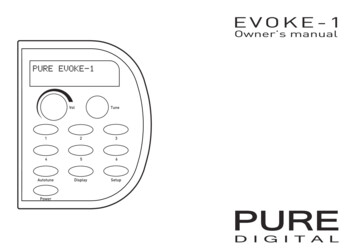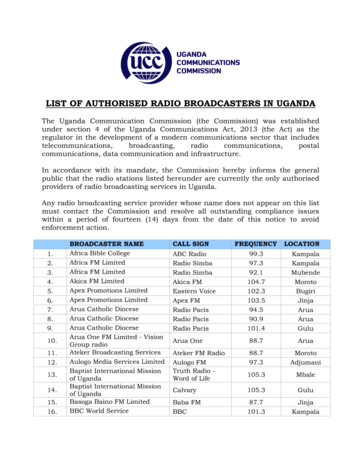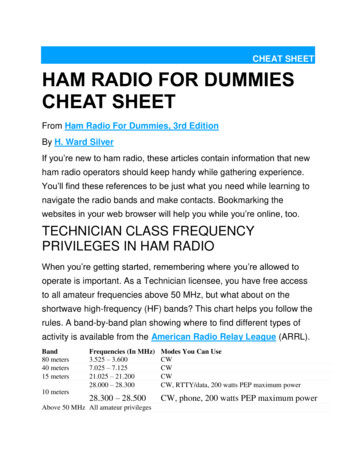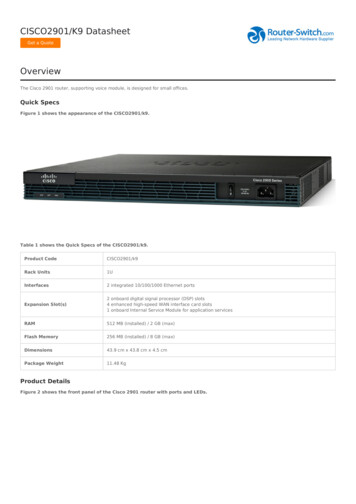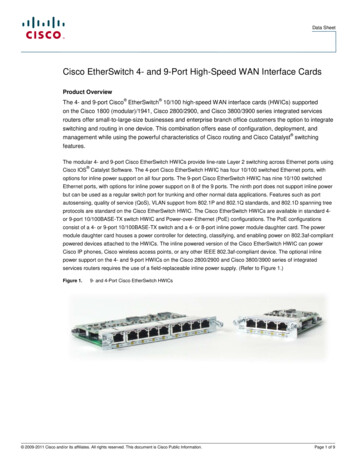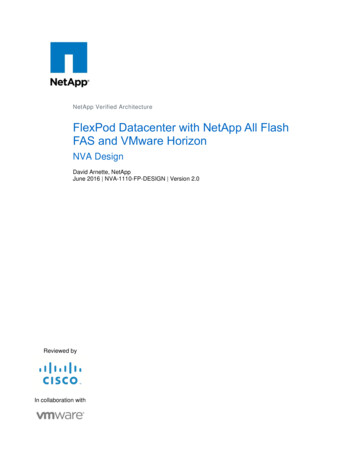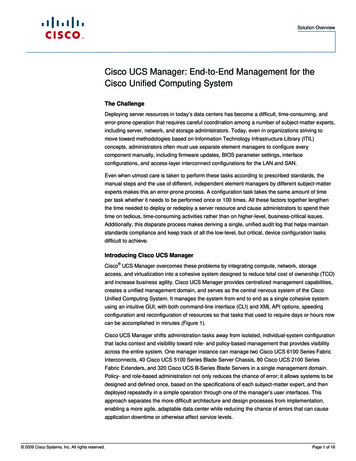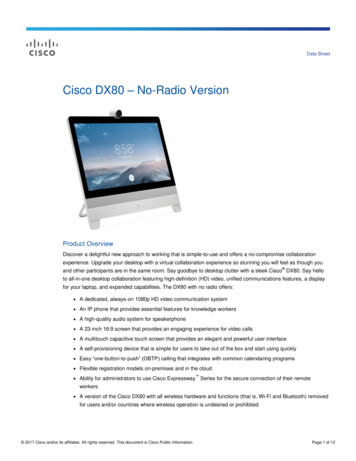
Transcription
Data SheetCisco DX80 – No-Radio VersionProduct OverviewDiscover a delightful new approach to working that is simple-to-use and offers a no-compromise collaborationexperience. Upgrade your desktop with a virtual collaboration experience so stunning you will feel as though youand other participants are in the same room. Say goodbye to desktop clutter with a sleek Cisco DX80. Say helloto all-in-one desktop collaboration featuring high-definition (HD) video, unified communications features, a displayfor your laptop, and expanded capabilities. The DX80 with no radio offers: A dedicated, always-on 1080p HD video communication system An IP phone that provides essential features for knowledge workers A high-quality audio system for speakerphone A 23-inch 16:9 screen that provides an engaging experience for video calls A multitouch capacitive touch screen that provides an elegant and powerful user interface A self-provisioning device that is simple for users to take out of the box and start using quickly Easy “one-button-to-push” (OBTP) calling that integrates with common calendaring programs Flexible registration models on-premises and in the cloud Ability for administrators to use Cisco Expressway Series for the secure connection of their remoteworkers A version of the Cisco DX80 with all wireless hardware and functions (that is, Wi-Fi and Bluetooth) removedfor users and/or countries where wireless operation is undesired or prohibited 2017 Cisco and/or its affiliates. All rights reserved. This document is Cisco Public Information.Page 1 of 12
Features and BenefitsTable 1 lists the features and benefits of the Cisco DX80.Table 1.Features and BenefitsFeatureBenefitDesign features Ability to install in minutes: The DX80 is an integrated device with fully touch-based on-screen controls. Just plug in thepower cable and network. Get started with a simple set-up wizard. Authenticate to complete the setup. In-person video: With a large 23-inch screen and best-in-class video and audio capabilities, the DX80 allows for life-likeexperiences. Top-notch monitor: You can use the DX80 as an external monitor when plugged into a laptop. It has a high-contrastLED panel with a wide viewing angle and a full touch surface. Document camera: You can tilt the camera located on top of the DX80 down to allow sharing of physical content anddrawings. Inclinable screen: The DX80 accommodates users who want to sit and use it at a reclined angle to type or draw at theirdesk comfortably. You can easily pull the device toward yourself; it reclines to a 40 angle to the table.Content-sharingfeatures Share multimedia and presentations at the touch of a button: While on a call, you can see the laptop screen and share itinstantly in full HD with the on-screen control bar. Enjoy the easy on-screen control interface accessible with a single tap on the screen.Performancefeatures The system offers simultaneous HD video and content sharing. Audio is communicated through full-duplex, full-band audio (CD quality). Provisioning and configuration are easy with Cisco Unified Communications Manager or with Cisco TelePresence Video Communication Server (VCS) and Management Suite (TMS). The DX80 registers to Cisco VCS and Session Initiation Protocol (SIP)-based call controls, Cisco Unified.Registrationmodels The DX80 also registers to Cisco Spark in the Cisco Collaboration Cloud.Product SpecificationsTable 2 lists the specifications of the Cisco DX80.Table 2.Product SpecificationsFeatureBenefitComponentsFully integrated unit including: Codec Camera Display Microphones and loudspeakerIncluded: Screen cleaning cloth, HDMI cable (2m), USB cable (2m), Ethernet cable (2.9m), and power supplyDisplay 23-inch (0.58m) LCD monitor Resolution: 1920 x 1080 (16:9) High-contrast IPS LED panel Contrast ratio: 1000:1 (typical) Viewing angle: /–178 degrees (typical) Response time: 5 ms (typical) Brightness: 215 cd/m2 (typical) Color depth: 16.7 million colors Color gamut 72% (of NTSC) 10-point multitouch surfaceSupported PCinput resolutionsErgonomic designUp to 1080p The stand is retractable in the upright position for easy transportation. You can tilt the screen from an angle of 11 to 50 from the vertical. You can tilt the camera from an angle of –5 to 70 from the display. You can lift the connector lid fully and lock it to the back of the unit with magnets. 2017 Cisco and/or its affiliates. All rights reserved. This document is Cisco Public Information.Page 2 of 12
FeatureAudioBenefit The loudspeaker is mounted on the front panel and faces you. Four digital microphones are mounted in two arrays. Loudspeaker frequency range: 70 Hz to 20 kHz Microphones frequency range: 100 Hz to 20 kHzFront camera 63 horizontal field of view 38 vertical field of view Resolution: 1080p30 F 2.2 Privacy shutterProcessorTI OMAP 4470 1.5-GHz dual-core ARM Cortex-A9 processorStorage8-GB eMMC NAND flash memory (embedded multimedia card; nonvolatile)Memory2-GB RAM; Low Power Double Data Rate Synchronous Dynamic Random-Access Memory (LPDDR2 SDRAM)Ports and slots High-Definition Multimedia Interface (HDMI) type A port for PC or Mac video input HDMI type A port output (reserved for future use) High-speed USB 2.0 ports: Physical buttonsThree standard type A ports enable wired or wireless (dongle) headsets and handset useOne standard type B port (reserved for future use)One Micro-B USB port with native RS-232 (serial port, intended for service only)Maximum of 500-mA power output at 5V or 2.5W for each USB port Volume up/down MuteVisual indicator Camera LED indicator (incoming calls and camera activation) Microphone LED indicator (mute) Power button LED indicator (power on, sleeping, message waiting, and error)Physicaldimensions(H x W x D)20.2 x 22.2 x 3.5 in. (51.2 x 56. 5 x 8.9 cm)Weight15.65 lb (7.1 kg)PowerRated: 60W maximumLow-power standby modePhysical securityCompatible with Kensington Security SlotConnectivityEthernet Internal 2-port Cisco Ethernet switch allows for a direct connection to a 10/100/1000BASE-T Ethernet network(IEEE802.3i/802.3u/802.3ab) through an RJ-45 interface with single LAN connectivity for both the phone and a colocated PC. The system administrator can designate separate VLANs (IEEE 802.1Q) for the PC and phone, providing improvedsecurity and reliability of voice and data traffic.AccessoriesCisco VESAmounting kitThe optional mounting kit includes an adapter that replaces the DX80 foot stand and provides mounting points for 75- x 75mm and 100- x 100-mm VESA, allowing the use of third-party mounting solutions or the basic flush wall-mount included withthe kit.Temperature RangeOperatingtemperature 32 to 104 F (0 to 40 C)Relative humidity 10% to 90% (noncondensing)Storagetemperature –4 to 140 F (–20 to 60 C) 2017 Cisco and/or its affiliates. All rights reserved. This document is Cisco Public Information.Page 3 of 12
FeatureBenefitApprovals and Compliance Directive 2014/35/EU (Low-Voltage Directive) Directive 2014/30/EU (EMC Directive) – Class A Directive 2014/53/EU (Radio Equipment Directive) Directive 2011/65/EU (RoHS) Directive 2002/96/EC (WEEE) NRTL approved (Product Safety) FCC CFR 47 Part 15B (EMC) – Class B FCC Listed (Radio Equipment)Firmware Options and FeaturesThe Cisco DX70 and DX80, MX, and SX Series all support the Cisco Collaboration Endpoint (CE) Software. CEsoftware is configurable for the Cisco Spark Service and for both Cisco HCS and on-premises deployments(registered to Cisco Unified Communications Manager, Cisco Video Communication Server, or even standalonewith H.323). For the time being, the capabilities offered by these configurations do vary. Table 3 describes thecapabilities common to both. Table 4 lists the additional on-premises features, and Table 5 lists the majordifferences for the Cisco Spark Service.In addition, the DX Series can also run on Android-based software. This software is compatible only with CiscoUnified Communications Manager. Table 6 summarizes the Android-based software.The DX70 and DX80 are planned to ship with CE software by default starting in the second half of 2016.Table 3.Features Common to the Cisco Spark Service and On-Premises Registered EndpointsFeatureCisco CE 8.3.0 Software for Managed and HostedVideo inputsSupport for formats up to maximum 1920 x 1080 @ 30 fps (HD1080p30), including: 640 x 480 720 x 480 800 x 600 1024 x 768 1280 x 720 1366 x 768 1920 x 1080High-definition inputs use progressive video formats.Extended Display Identification Data (EDID)Live videoresolutions 176 x 144 @ 30 fps (QCIF) (decode only) 352 x 288 @ 30 fps (CIF) 512 x 288 @ 30 fps (w288p) 576 x 448 @ 30 fps (448p) 768 x 448 @ 30 fps (w448p) 704 x 576 @ 30 fps (4CIF) 1024 x 576 @ 30 fps (w576p) 640 x 480 @ 30 fps (VGA) 800 x 600 @ 30 fps (SVGA) 1024 x 768 @ 30 fps (XGA) 1280 x 1024 @ 30 fps (SXGA) 1280 x 720 @ 30 fps (720p30) 1280 x 768 @ 30 fps (WXGA) 1920 x 1080 @ 30 fps (1080p30) 1440 x 900 @ 30 fps (WXGA ) 1680 x 1050 @ 30 fps (WSXGA ) 2017 Cisco and/or its affiliates. All rights reserved. This document is Cisco Public Information.Page 4 of 12
FeatureCisco CE 8.3.0 Software for Managed and HostedAudio features Up to 48-kHz sampling rate High-quality 20-kHz stereo audio Acoustic echo cancellers Automatic Gain Control (AGC) Automatic noise reductionLanguage supportTable 4.Arabic, Catalan, Czech, Danish, Dutch, English, Finnish, French, German, Hebrew, Hungarian, Italian, Japanese, Korean,Norwegian, Polish, Portuguese-Brazilian, Russian, Simplified Chinese, Spanish, Swedish, Traditional Chinese, and Turkish;depends on software version. For regions that support Cisco Spark Service, please visit: cs.co/geos.Software Features for Endpoints Registered On-Premises or Cisco HCSFeatureCisco CE 8.3.0 SoftwareBandwidthH.323 and SIP: Up to 3 Mbps point to pointMinimumbandwidth forresolution/framerate720p30 from 768 kbpsFirewall traversalCisco TelePresence Expressway technologyVideo standardsH.263, H.263 , H.264, and AVC (H.264/MPEG-4 Part 10 Advanced Video Coding)Video features1080p30 from 1472 kbps On-screen layout control for video and presentation Active control (participants list, active speaker and content sharing, end participant call, and muted participants) Layout controls Self-View Far-end camera controlAudio standards64- and 128-kbps AAC-LD, OPUS, G.722, G.722.1, G.711mu, G.711a, G.729ab, and G.729Audio features Active lip synchronizationDual stream H.239 (H.323) dual stream Binary Floor Control Protocol (BFCP) (SIP) dual stream Support for resolutions up to 1080p (1920 x 1080)Multipoint supportEmbeddedencryptionCisco Ad-Hoc Conferencing (requires Cisco Unified Communications Manager, Cisco HCS, Cisco TelePresence Server,and Cisco TelePresence Conductor) SIP point-to-point Standards-based: Advanced Encryption Standard (AES) Automatic key generation and exchange Supported in dual streamCalling features Dialing (ITU E.164) Add consultative call Adjustable ringing and volume levels Adjustable display brightness Auto-answer Auto-detection of headset Call forward Call forward notification Call-history lists Caller ID Corporate directory Conference (ad hoc) Do Not Disturb (DND) Extension Mobility service Favorites Hold (and resume) Join (ad hoc merge) Message waiting indicator Mute (audio and video) 2017 Cisco and/or its affiliates. All rights reserved. This document is Cisco Public Information.Page 5 of 12
FeatureCisco CE 8.3.0 Software Network profiles (automatic) Self-View (video call) One-button-to-push (OBTP) Shared line Single Number Reach (SNR) Transfer VoicemailUsing the CiscoProximity app tonavigate the videosystemWhen entering a room or area with a DX endpoint, both the DX and the Cisco Proximity application visually indicate thatthey are paired or connected together. This pairing provides the following capabilities: Video system control: Use the Cisco Proximity app on a mobile device to initiate, answer, or hang up a call on the onpremises registered endpoint. You can also move the call from the mobile device to the DX and vice versa. View shared content: Use the Cisco Proximity app on a mobile device to view the content being shared. Use the CiscoProximity app on a laptop to share the content wirelessly in and out of a call. The Cisco Proximity app on iOS, Android, Windows, and MacOS is enabled for pairing by default. Control is available toanyone with the Cisco Proximity app. Alternatively, users who do not have a mobile or desktop device or the CiscoProximity app can control the system with the DX touchscreen.IP networkfeatures Domain Name System (DNS) lookup for service configuration Differentiated Services (quality of service [QoS]) IP adaptive bandwidth management (including flow control) Dynamic playout and lip-sync buffering Date and Time support with Network Time Protocol (NTP) Packet loss-based down speeding URI Dialing TCP/IP Dynamic Host Configuration Protocol (DHCP) 802.1x network authentication 802.1Q virtual LAN 802.1p (QoS and class of service [CoS]) Clear Path v1 and v2In-room controlsWith in-room controls, you can add custom elements to the user interface. Controls for lights, blinds, or other peripheralscan be added to the DX interface. Custom panel creation from the web UI interface Global panel accessible in the system bar tray Home screen panel accessible from the control tray In-call panel accessible from the in-call trayCall controlregistration Native registration with Cisco Unified Communications Manager (requires Cisco Unified Communications ManagerVersion 8.6 or later) Basic Cisco Unified Communications Manager provisioning Firmware upgrade from Cisco Unified Communications Manager Cisco Discovery Protocol and DHCP option 150 supportIPv6 networksupport Dual-stack IPv4 and IPv6 for DHCP, Secure Shell (SSH) Protocol, HTTP, Secure HTTP (HTTPS), DNS, andDifferentiated Services (DiffServ) Support for both static and auto configuration (stateless address auto configuration)Security features Management through HTTPS and SSH IP administration password Menu administration password Disable IP services Network settings protectionSystemmanagement Support for the Cisco TelePresence Management Suite (TMS) Total management through embedded Simple Network Management Protocol (SNMP), Telnet, SSH, XML, and SimpleObject Access Protocol (SOAP) Remote software upload: Through web server, HTTP, and HTTPS 2017 Cisco and/or its affiliates. All rights reserved. This document is Cisco Public Information.Page 6 of 12
FeatureCisco CE 8.3.0 SoftwareDirectory services Support for local directories (My Contacts) Corporate directory (through Cisco Unified Communications Manager and Cisco TMS) Server directory supporting Lightweight Directory Access Protocol (LDAPP and H.350 (requires Cisco TelePresenceManagement Suite) Call history with received, placed, and missed calls with date and timeLanguage supportArabic, Catalan, Czech, Danish, Dutch, English, Finnish, French, German, Hebrew, Hungarian, Italian, Japanese, Korean,Norwegian, Polish, Portuguese-Brazilian, Russian, Simplified Chinese, Spanish, Swedish, Traditional Chinese, and Turkish;depends on software versionWhen registered to the Cisco Spark Service, the DX70 and DX80 can call other endpoints including other Ciscoroom systems, tablets, PCs, and Macs using URI dialing.* The services offered in this configuration are listed inTable 5. Also, if you have meetings with more than three parties, you can use the DX70 and DX80 with anymeeting services such as Cisco Spark meetings or Cisco WebEx on Annuity.Table 5.Software Features for the Cisco Spark Service or Cisco WebEx on AnnuityFeatureCisco CE 8.3.0 Software for Cisco Spark Room SystemCalling intoanother audio orvideo deviceVideo devices registered to Cisco Spark Service can call to any other Cisco Spark registered system as well as standardsbased video and conferencing systems using URI dialing only. The Cisco Spark service enables video conferencing withSkype for business.Bitrate and videoqualityVideo calls will typically allow currently up to 720p30fps in a point-to-point call.In a multiparty call, the Cisco Spark system will send several independent streams and maintain a constant bitrate.In conditions where the network does not allow full bitrate, the rate will be automatically adjusted and the video gracefullydegraded.Firewall traversalCisco Spark meeting service does not require additional equipment for firewall traversal.Refer to this article for more information: for-the-cisco-spark-app.Video and audiostandardsVideo featuresDevices registered Cisco Spark will typically use H.264 for video and OPUS for audio. On-screen layout control for video and presentation Active control (participants list, active speaker and content sharing, and end participant call) Self-ViewContent sharing Up to 1080p5fpsMultiparticipants Multiparty meetings are supported by call control or the Cisco Spark meeting service, not the endpoint itself.Pairing for roomsystem controland moving callsWhen entering a room or area with a DX endpoint, both the DX and the Cisco Spark application visually indicate that theyare paired or connected together. This pairing provides the following capabilities: Room system control: Use the Cisco Spark app on a mobile device to initiate, answer, or hang up a call on the CiscoSpark Room System. Move calls: Smoothly move a call from the Cisco Spark app on a mobile device to a Cisco DX when walking into theroom. Or move a call from the Cisco DX to the Cisco Spark app when leaving the conference room. The Cisco Spark app on iOS and Android is enabled for pairing by default. Control is available to anyone with a CiscoSpark app, even the free version. Alternatively, users who do not have a mobile or desktop device or the Cisco Sparkapp can control the system with the DX touch screen.*Note: When registered to the Cisco Spark service, the DXs do not have telephony capabilities, such as the abilityto place or receive phone calls. They have URI dialing capabilities only.For more information about Cisco Spark Room Systems, read the Cisco Spark data sheet.Table 6.Software Features for the Android-Based SoftwareFeatureAndroid corefeaturesSpecifications Fully customizable Cisco Launcher and App Tray “Home Screen” enables you to place your own application shortcuts,widgets, and folders. Home Screen supports up to five separate screen views or pages with a 12 x 9 icon grid. Landscape-orientated applications are supported. On-screen keyboard is supported. 2017 Cisco and/or its affiliates. All rights reserved. This document is Cisco Public Information.Page 7 of 12
FeatureAndroid bundledapplications andwidgetsSpecifications CalculatorCalendarCameraClockContactsDirect dialEmail Internet Message Access Protocol (IMAP) Post Office Protocol 3 (POP3) Microsoft Exchange ActiveSync Google bundledapplications Google Play (enabled by administrator through Cisco Unified Communications Manager; includes country-approvedGoogle mobile services applications) Cisco bundledapplicationsFavoritesGalleryPhone features (for example, forward all, privacy, Do Not Disturb (DND), mobility, and Self-View)Wallpapers (including live wallpapers)Web browserGmailGoogle settingsMapsPlay BooksPlay MagazinesPlay MoviesPlay MusicGoogle Now Cisco AnyConnect Secure Mobility Client (VPN) Cisco Jabber Instant Messaging (which offers chat and presence capabilities) Cisco WebEx conferencing Quick Contact Badge (allows you to easily collaborate with your contacts to place a call, send an email message, sendan instant message [IM], or start a WebEx meeting) Visual VoicemailConfigurationmodes Enhanced, fully functional mode that enables all aspects of the phone including applications and accounts Simple mode that hides applications and accounts and provides only voice and video call capabilities Public mode based on simple mode with restrictions on user settings modificationsApplicationdeploymentoptions andmanagement The administrator can disable downloading of all applications on the Cisco DX650, DX70, and DX80. Specifically, theadministrator can configure the DX650, DX70, and DX80 to prohibit the installation of any third-party Androidapplications. Google Play access can be administratively disabled (default). Applications from “unknown sources” can beadministratively disabled (default): The administrator can optionally install applications using Cisco Unified Communications Manager with the APK file. With Company Photo Directory (ability to set up and link photo directory URL image location associated withrespective user), the administrator can set up and link a photo-directory URL image location associated with arespective user.Built-in trainingand nguage support Setup Assistant wizard (helps configure email, Jabber IM, WebEx conferencing, and voicemail account settings)Cisco Collaboration application programming interfaces (APIs) through a Software Developer Kit rview/index.gsp Arabic, Egypt (ar EG) Bulgarian, Bulgaria (bg BG) Catalan, Spain (ca ES) Chinese, PRC (zh CN) Chinese, Taiwan (zh TW) Croatian, Croatia (hr HR) Czech, Czech Republic (cs CZ) Danish, Denmark (da DK) Dutch, Netherlands (nl NL) 2017 Cisco and/or its affiliates. All rights reserved. This document is Cisco Public Information.Page 8 of 12
FeatureSpecifications English, Britain (en GB) English, United States (en US) Finnish, Finland (fi FI) French, France (fr FR) German, Germany (de DE) Greek, Greece (el GR) Hebrew, Israel (he IL) Hungarian, Hungary (hu HU) Italian, Italy (it IT) Japanese (ja JP) Korean (ko KR) Latvian, Latvia (lv LV) Lithuanian, Lithuania (lt LT) Norwegian bokmål, Norway (nb NO) Polish (pl PL) Portuguese, Brazil (pt BR) Portuguese, Portugal (pt PT) Romanian, Romania (ro RO) Russian (ru RU) Serbian, Republic of Serbia (sr RS) Slovak, Slovakia (sk SK) Slovenian, Slovenia (sl SI) Spanish, Spain (es ES) Swedish, Sweden (sv SE) Thai, Thailand (th TH) Turkish, Turkey (tr TR)Calling featuresupport Dialing (ITU E.164) Abbreviated dialing Adjustable ringing and volume levels Adjustable display brightness Auto-answer Auto-detection of headset Barge (cBarge) Callback Call Chaperone Call forward Call forward notification Call-history lists Call park (including Directed Call Park and Assisted Directed Call Park) Call pickup Call timer Call waiting Caller ID Corporate directory Conference (ad hoc) Direct transfer Divert (iDivert) Do Not Disturb (DND) Cisco Extension Mobility service Fast-dial service Forced-access codes and client matter codes Group call pickup Hold (and resume) Intercom International call logging 2017 Cisco and/or its affiliates. All rights reserved. This document is Cisco Public Information.Page 9 of 12
FeatureSpecifications Join (ad hoc) Last-number redial (LNR) Malicious-caller ID Message-waiting indicator (MWI) Meet-me conference Mobility (Cisco Mobile Connect and Mobile Voice Access) Music on hold (MoH) Mute (audio and video) Network profiles (automatic) On- and off-network distinctive ringing Personal directory PickUp Predialing before sending Privacy Private Line Automated Ringdown (PLAR) Ring tone per line appearance Self-View (video call) Service URL Shared line(s) Silent Monitoring and Recording Time and date display Transfer (ad hoc) Visual Voicemail VoicemailEmergencyservicesEmergency Calling Service dialingAccessibilityfeaturesAdditional accessibility features for the vision impaired, blind, and the hearing and mobility impaired include user-definedand customizable: Display font size and screen brightness settings Touchscreen customizable touch and hold delay Talkback audio prompts and spoken password Support for Explore by Touch featuresSecurity FeaturesHardware Secure boot Secure credential storage Device authentication File authentication and encryption Image authentication and encryption Signaling authentication Random bit generation Hardware cryptographic acceleration Encrypted configuration files Encrypted file systemCertificatemanagement Certificate Authority Proxy Function (CAPF) support for additional security Manufacturer-Installed Certificates (MIC) Locally Significant Certificates (LSC) X.509 Digital Certificates (DER encoded binary); both DER and Base-64 formats are acceptable for the client and servercertificates; certificates with a key size of 1024, 2048, and 4096 are supportedNetwork Wired: 802.1X supplicant options for network authentication use: Extensible Authentication Protocol: Extensible Authentication Protocol - Flexible Authentication via Secure Tunneling(EAP-FAST) Extensible Authentication Protocol: EAP Transport Layer Security (EAP-TLS) Protected Extensible Authentication Protocol - Generic Token Card (PEAP-GTC) 2017 Cisco and/or its affiliates. All rights reserved. This document is Cisco Public Information.Page 10 of 12
FeatureSpecificationsMedia and datasignaling TLS Secure Real-Time Transport Protocol (SRTP) HTTPS for clientsEnterprise access Cisco AnyConnect Secure Mobility Client Web Proxy (manual configuration or auto configuration of Protected Access Credential [PAC] files) NT LAN Manager (NTLM) and Kerberos authenticationDevicemanagement Remote wipeActiveSync remote wipe (email, contacts, calendar, etc.)Self-service wipeWipe after unsuccessful login attemptsFactory resetPolicymanagement Password complexityAbility to disable USBAbility to disable speakerphoneAbility to disable headsetSecure digital I/O (SDIO) enable/disableAccess to Android marketScreen lock and automatic lock (Personal Identification Number [PIN] or password) deviceAndroid Debug Bridge (ADB)Diagnostics The integrated Cisco Collaboration Problem Report Tool can send information directly to your system administratorwhen you experience problems with your phone or application (requires a configured email account).LicensingPhone licensing depends on the call-control platform and its policies. For the Cisco Unified CommunicationsManager, the Cisco DX80 requires a minimum-level Enhanced IP User Connect License (UCL). There are nospecial licenses plus phone bundles for tier-2 distributors. The DX80 is not supported on third-party call-controlsystems.Warranty InformationThe DX Series endpoints are covered by the Cisco 1-Year Limited Hardware Warranty. Find warranty informationon Cisco.com at the Product Warranties page.Ordering InformationTables 7 through 9 give ordering information to help customers understand all the components or parts they needto purchase in order to install and use the product.To place an order, visit the Cisco Ordering Home Page. To download software, visit the Cisco Software Center.Table 7.Ordering InformationProduct NamePart NumberCisco DX80 no radio versionCP-DX80-NR-K9 Cisco DX80 TAA, no radio versionCP-DX80-NR-K9 Table 8.Replacement PartsProduct NamePart NumberHDMI/USB grey cable for Cisco DX80CAB-COMBO-2M Ethernet grey cable for Cisco DX80CAB-GREY-2.9M Foot stand for Cisco DX80CP-DX80-FS Power transformer for the DX70 and DX80 seriesCP-PWR-CUBE-5 2017 Cisco and/or its affiliates. All rights reserved. This document is Cisco Public Information.Page 11 of 12
Table 9.AccessoriesProduct NamePart NumberCisco VESA adapter and wall mounting optionCP-DX80-VESA Cisco ServicesCisco Services make networks, applications, and the people who use them work better together.Today, the network is a strategic platform in a world that demands better integration between people, information,and ideas. The network works better when services, together with products, create solutions aligned with businessneeds and opportunities.The unique Cisco Lifecycle approach to services defines the requisite activities at each phase of the networklifecycle to help ensure service excellence. With a collaborative delivery methodology that joins the forces of Cisco,our skilled network of partners, and our customers, we achieve the best results.Cisco CapitalFinancing to Help You Achieve Your ObjectivesCisco Capital can help you acquire the technology you need to achieve your objectives and stay competitive. Wecan help you reduce CapEx. Accelerate your growth. Optimize your investment dollars and ROI. Cisco Capitalfinancing gives you flexibility in acquiring hardware, software, services, and complementary third-party equipment.And there’s just one predictable payment. Cisco Capital is available in more than 100 countries. Learn more.For More InformationFor more information about the Cisco DX80, visit http://www.cisco.com/go/dx or contact your local Cisco accountrepresentative.Printed in USA 2017 Cisco and/or its affiliates. All rights reserved. This document is Cisco Public Information.C78-736570-0304/17Page 12 of 12
The Cisco DX70 and DX80, MX, and SX Series all support the Cisco Collaboration Endpoint (CE) Software. CE software is configurable for the Cisco Spark Service and for both Cisco HCS and on-premises deployments (registered to Cisco Unified Communications Manager, Cisco Vi




